Light and easy to set up, inflatable kayaks take all the headaches out of owning a boat.
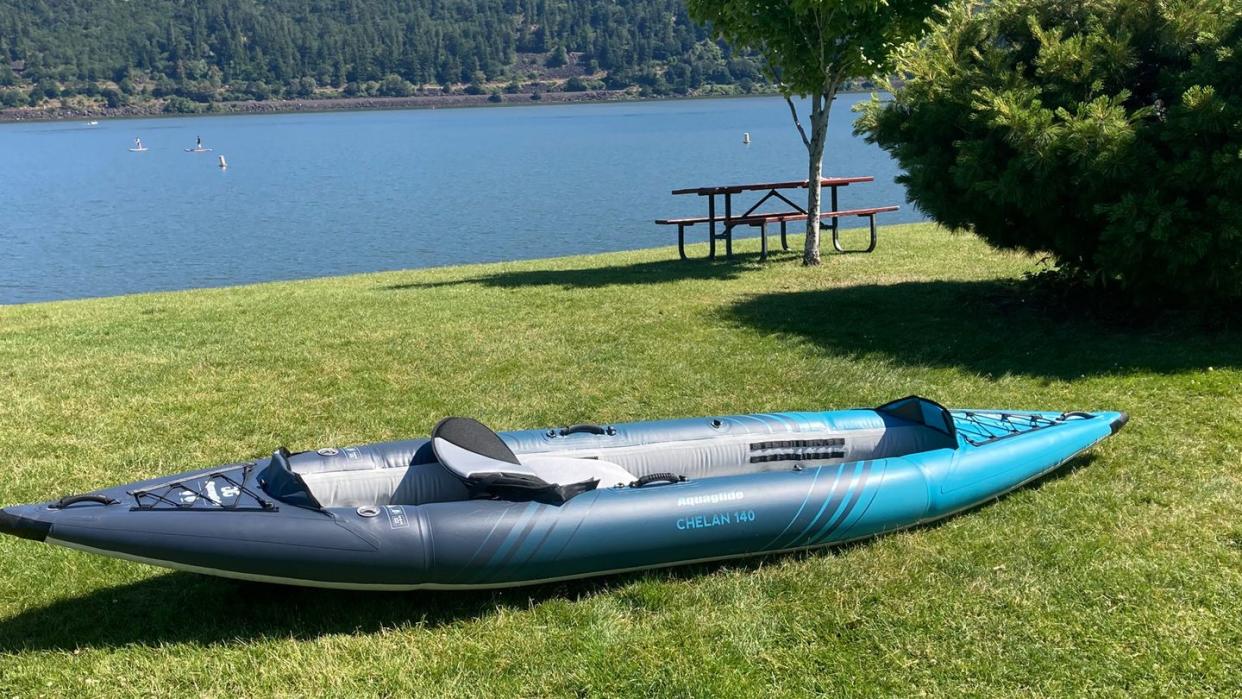
"Hearst Magazines and Yahoo may earn commission or revenue on some items through these links."
Inflatable kayaks are a great way to get out on the water, whether you’re fishing a local pond, touring a tranquil bay, or splashing your way through whitewater. Stable, sleek and, above all, fun, they make it easy to get in the water and start exploring.
The biggest benefits, though, come before and after a paddle. While deflated, you can roll them up and store them in a closet or the trunk of your car, instead of taking over your entire garage. Some are small enough to even take backpacking. Pump them up and you have a high-performance boat that’s forgiving and sturdy enough to let you safely navigate rivers, streams, lakes, bays and more. And while popping is technically a possibility, they’re quite durable–capable of withstanding bumps and bruises from rocks and other obstructions along the way.
Whatever type of kayak you need–for touring, whitewater, or even fishing–we have some thoughts about the best inflatable kayaks you can buy right now. We’ve even seen a couple of interesting innovations, like a “hybrid” craft that doubles as an inflatable paddleboard, and high-performance options made with the same drop-stitch technology found in standup paddleboards. There’s never been a better time to either dip your toe into the wonderful world of inflatable kayaks, or to add one to your current flotilla of paddlecraft.
Spend Your Summer On The Water: Best Wakeboards, Best Life Jackets, Best Water Skis
Best Inflatable Kayaks
Best Overall: Aquaglide Chelan 140
Best Value: Intex Explorer K2
Best for Two People: Intex Excursion Pro K2
Best for a Trio: Sea Eagle 370 Pro
Best for Whitewater: Aire Force
The Expert (Joe Jackson): I got my start in outdoor journalism at the now folded Paddler Magazine (rest in peace, Paddler) and have been testing and writing about kayaks professionally since 2008. I was the boat category testing manager for Outside Magazine for a decade and also helped coordinate testing for Canoe and Kayak magazine where I worked as a contributing editor. I have tested hundreds of boats in conditions ranging from open ocean crossings, to class V rapids, to sprint workouts in heavily polluted urban waterways. The types of boats have ranged from handmade sealskin legacy craft to corrugated plastic prototypes.
The Expert (Eugene Buchanan): As the editor-in-chief of Paddler magazine and founder of Paddling Life, boating has been in my blood for nearly four decades. I’ve tested every type of paddlecraft under the sun—hundreds if you’re looking for a number. I’ve run rivers in more than 30 countries on six continents, from Africa’s Zambezi to the Futaleufu in South America, and worked as a raft and sea kayak guide, as well as a whitewater kayak instructor.
As a journalist, I’ve covered boating and outdoor sports for more than 30 years, including for ESPN, NBC, The New York Times, Outside, Men's Journal and National Geographic Adventure. I’ve also written four books about kayaking–Brothers on the Bashkaus (2007); Outdoor Parents, Outdoor Kids (2010); Ultimate Canoe and Kayak Trips (2014); and Comrades on the Colca (2016).
What to Consider When Picking an Inflatable Kayak
Kinds of Kayaks
There are about as many types of inflatable kayaks as there are styles of kayaking. Some are made for simply hanging out on a lake. Others are made for specific purposes, like fishing or whitewater. Depending on what you need, you may want to look for a kayak made with heartier materials, or for advanced design features, like a rockered bow to help navigate over larger water features in a river.
General or “recreation” kayaks are the most popular type of inflatables. “Rec” kayaks don’t have much in the way of specialized features, as they’re designed for protected waterways like bays and lakes. Since they lack specialty features, they are also the most affordable.
Fishing kayaks usually feature stable decks to give a stable platform for pulling in fish, and room for storing fishing gear. The inflatable apparatus can lend itself really well to fishing kayaks because they are traditionally monsters to store, and an inflatable can get an angler out and paddling even if they need to store the boat in an apartment.
Whitewater kayaks are built for the rigors of paddling down rushing rapids. Perhaps surprisingly, inflatable whitewater kayaks offer a beginner friendly entry point to riding rapids: They allow boaters to hop right back in if their boat gets flipped on a rapid—taking out the necessity of learning how to roll. The bouncy nature of an inflatable craft also makes navigating rocky or shallow rapids more forgiving for advanced paddlers.
Packrafts are an increasingly popular form of inflatable boat that can pack down into a backpacking pack with all of your other gear when deflated. Since they’re so easy to carry, packrafts really shine on trips that involve hiking to remote waterways, but they’re also really fun to kick around on over easy whitewater or on an alpine lake.
It may be overwhelming for beginners to sift through so many categories, so we suggest keeping your search simple. Think practically about what type of paddling you actually plan to do when choosing your lane for research. While we’d happily encourage you to aspire to a two week packrafting trip, it makes more sense to purchase a recreational design if you usually take your boat out for casual day trips.
Size
Generally speaking, a longer inflatable kayak is going to paddle more efficiently. Longer boats “track,” or glide in a straight line, more easily. That means you spend less time making correctional strokes to maintain your heading, so you can focus on propelling the boat forward. On the other hand, longer boats turn less quickly, which can make them feel unwieldy on tight, winding rivers and rapids, where you want more maneuverability.
For the most part, hard-shell kayaks track and maneuver better than inflatables. Even the slightest give in the hull of a boat can dramatically impact its performance: While high-end inflatables can blow up to create an extremely rigid hull, most inflatables do feature a small amount of give.
Ultimately, you should choose the size of your kayak to fit the kind of paddling you plan to do and the number of people coming along. That said, inflatables offer a great opportunity to size up if you’re on the fence. A kayak that is a foot longer inflated will likely only be a few inches larger deflated, and the extra space can offer the benefit of being a landing spot for a dog or a cooler.
Weight
There’s no reason to use an inflatable kayak if it’s too heavy to carry around. Perhaps surprisingly, they come in a wide range of weights–our picks alone range from 5.5 to 48 pounds. Always look for the lightest option available in a given size.
An ultralight boat, usually most suited for fast and light expeditions and packrafting, should come in at under 10 pounds. Core whitewater boats and heavy duty touring ones are largely going to be made from heavier duty plastics and will weigh 40 pounds or more. If you’re shopping for a heavier type of kayak, make sure it comes with a pack or wheelie system to help you transport it.
Price
While you can get a great inflatable kayak at a more reasonable price than you’d find with the best conventional kayaks, be careful about digging too deep into the bargain bin. Raft guides often refer to sub-$100 boats as “K-mart Coffins” because a poorly made inflatable can be quite dangerous. The plastic used in the cheapest boats was not made to handle the rigors of kayaking, and their seams are fickle—rarely holding air for more than a season.
A well-made recreational inflatable kayak can be affordable. If you let go of any plans for whitewater rafting or taking on the open ocean, you can get by with a barebones boat that may cost somewhere around $150 to $400. If you kayak frequently and want your boat to last, you may want to consider spending a little more on something more durable.
If you’re looking for a specialty kayak for rafting or fishing, which should feature high-grade PVC materials or rigidity champion-drop stitched floors, you should expect to spend around $800-$2,500.
Rigidity/PSI
A kayak that can safely hold more air will be more rigid. A more rigid kayak will hold its shape better, allowing it to track straighter and turn quicker. Some manufacturers will tell you how much air a kayak can hold, measuring rigidity pounds per square inch or PSI. That said, not every company discloses the spec, so you may have to do some research to find it.
Most boats will inflate to 1.5 to 2.5 PSI. An exceptionally rigid model can reach 2.5 to 3.5 PSI, which should hold a straight line in open water and hold an edge when paddlers lean out, similar to what you’d get from a hard-shell kayak.
Folding Vs Inflatable
If you are interested in saving space but are concerned about the overall performance of an inflatable, consider a folding kayak. Folding kayaks have a hard frame that folds up, allowing you to pack them up for storage. Inflatable kayaks are usually lighter and more portable than folding kayaks, but foldables track and maneuver more like a hard-shell kayak.
How We Selected The Best Inflatable Kayaks
To pick the best inflatable kayaks, we got out and paddled as many as we could, from the rivers of Colorado to tranquil and sunny Mission Bay in southern California. Eugene even joined a crew of 12 kayakers on a nine-day, self-support expedition to Lake Creek, Alaska. That crew had a collective 320 years of paddling experience between them. That’s a lot of butt time in boats.
We monitored each boat’s performance no matter where we took it, checking everything from tracking, to rigidity and durability. We also checked all the spec sheets, comparing materials, designs and manufacturing processes before giving them the thumbs up.
Chelan 140
The Chelan 140 is a versatile kayak with a winning combination of sturdy Duratex tube construction and a drop-stitch hard-bottom floor. Ideal for pairs or a solo journey with extra gear, it's designed for speed and paddling efficiency.
The front and rear spray guards keep occupants dry, while ample deck bungees allow for attaching your gear. Two seats with an inflatable base and high backrest enhance paddling comfort and can easily be moved or removed to accommodate one or two kayakers.
It also comes with plenty of storage, including ample mesh pockets and integrated fishing rod holders. At 33 pounds, it’s easy to transport in its backpack-style storage bag.
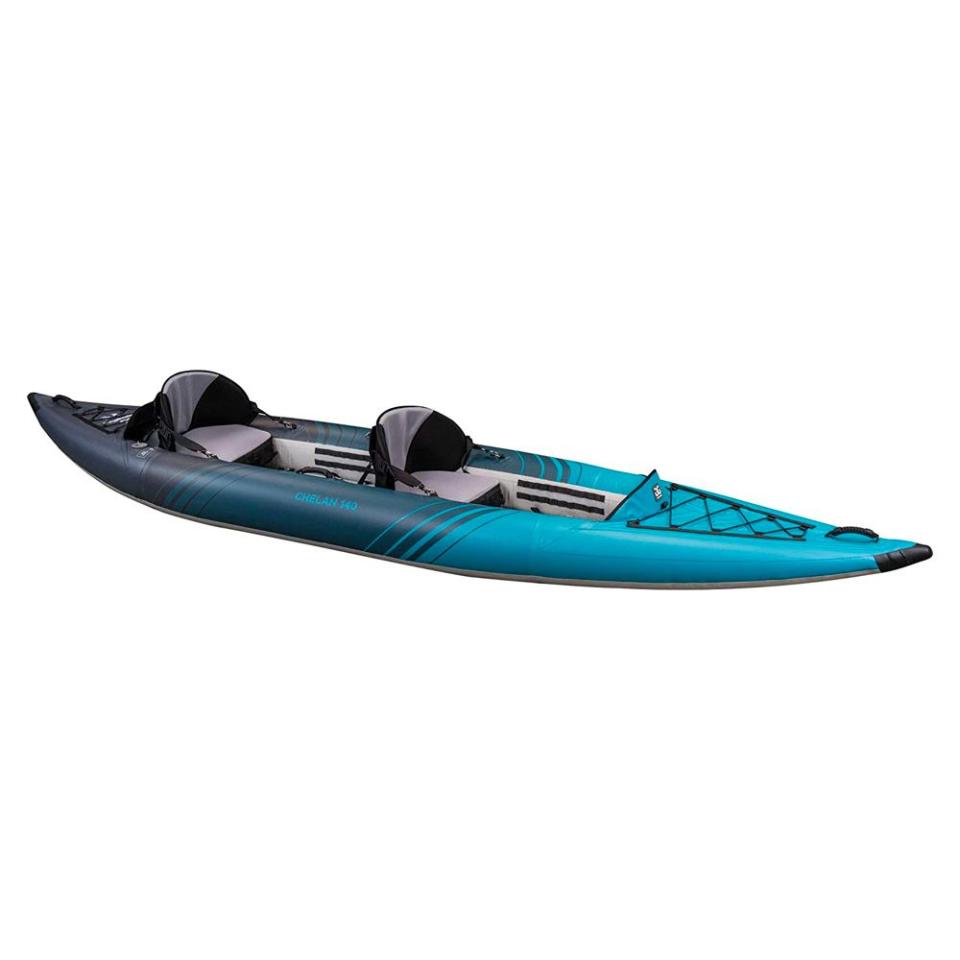
Chelan 140
amazon.com
$1099.99
Explorer K2
This affordable two-person kayak from Intex is an affordable pick for paddling around lakes and mild rivers. It comes with everything you need to get started, including two aluminum paddles, an air pump to inflate the kayak, and adjustable seats for paddler comfort on the water.
According to user reviews on Amazon, it’s surprisingly sturdy and easy to enter. We wouldn’t recommend bringing this one to the rapids or a long trip, but it’s no “K-Mart coffin,” and a solid casual pick for an easy day on the water.
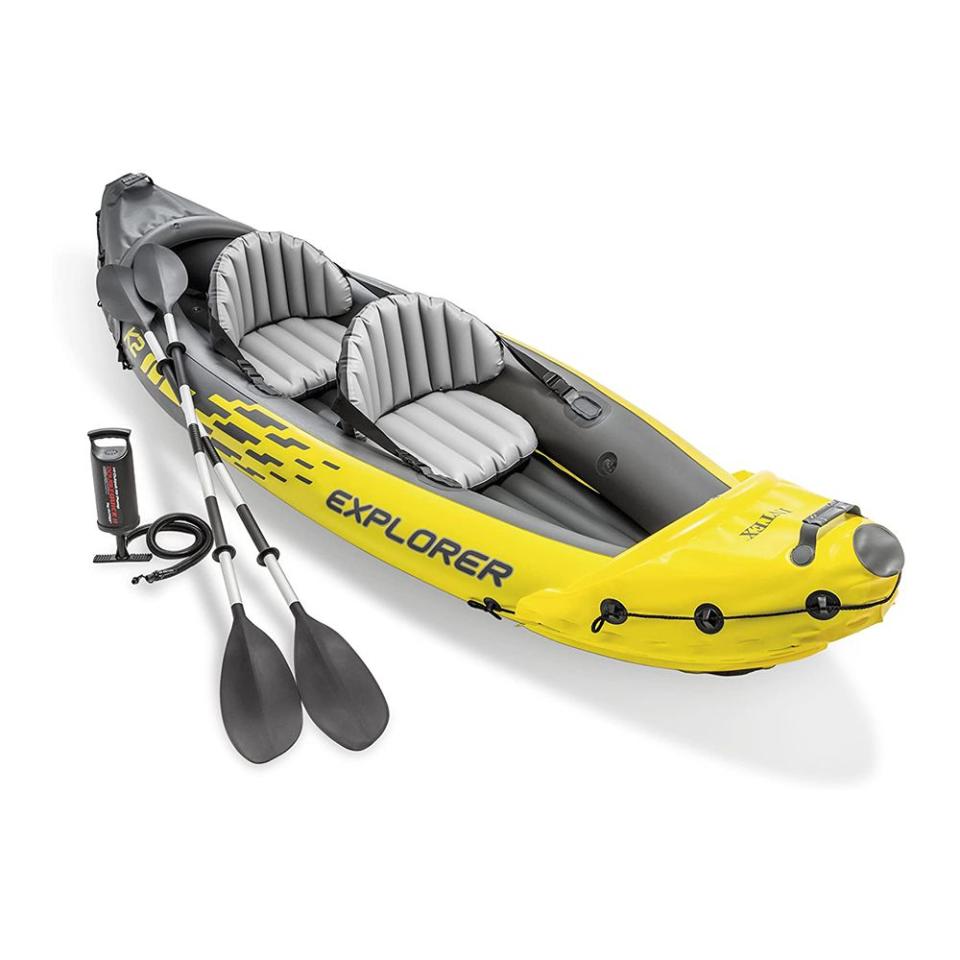
Explorer K2
amazon.com
$149.99
Excursion Pro K2
The Intex Excursion Pro K2 is a durable two-person fishing kayak made from a sturdy three-ply material with laminate PVC and a polyester core, all of which is designed to be highly damage-resistant and endure the the effects of gasoline, oil, and salt water.
It features an I-beam floor, two removable skews, two floor-mounted footrests, two adjustable seats, and two integrated recessed fishing rod holders. There are stainless steel D-rings in the bow and stern for stowing bags and gear. Included are a pump, two paddles, a pressure gauge, and a carrying bag.
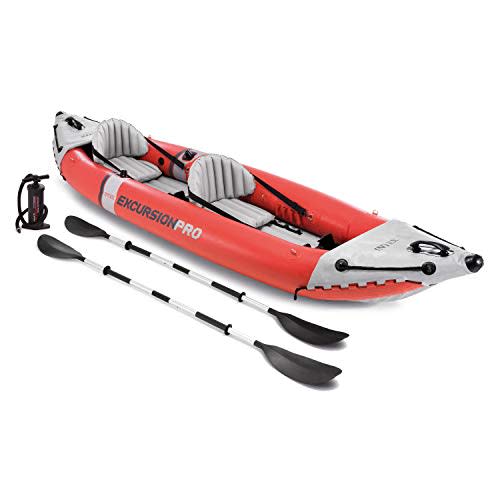
Excursion Pro K2
amazon.com
$252.00
370 Pro
If you need extra weight capacity to go out with a group, the Sea Eagle 370 Pro can handle a larger-than-average 650 pounds from up to three riders and is suited for up to Class III rapids. Large l-beam tubes on the bottom of the kayak create a durable floor as well as improve speed and tracking when in motion.
Weighing only 32 pounds, the Sea Eagle has two moveable kayak seats, as well as a pair of paddles, foot pump, and a carrying bag. Users say the Sea Eagle 370 Pro is a great entry point for beginners and veteran kayakers alike.
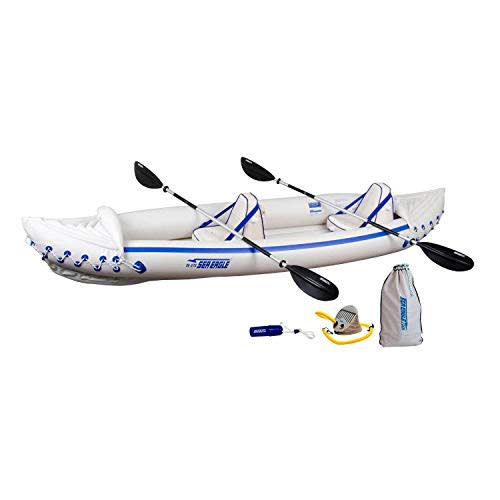
370 Pro
amazon.com
$642.99
Force
The Aire Force is the most expensive kayak in our guide, but the hearty, self-bailing inflatable from iconic whitewater brand Aire is worth every penny. Running rapids beats the hell out of a kayak, and the durable 1100-denier urethane plastic used to build the Force can take a beating. In fact, Aire is so confident in its work that it offers a 10-year warranty on the craft.
The highly adjustable cockpit and thigh straps allow paddlers to lean into their most important boof strokes, which make it class-V-capable if being steered by the right paddler. The Force’s heavy-duty mesh self-bailing floors — one of the brand’s signature features — gets water out of the cockpit of the boat quickly while adding an extra layer of durability to the base of the boat.
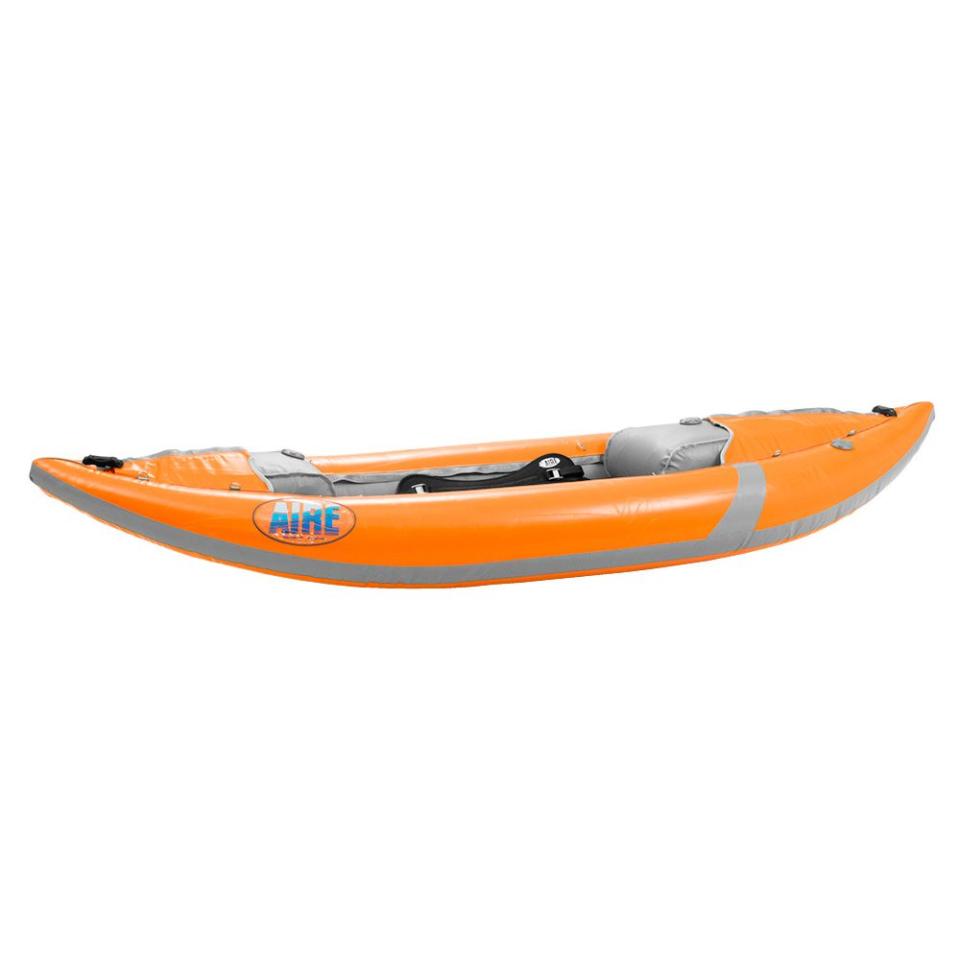
Force
aire.com
$2549.00
iEscape 110
The iEscape 110 marks kayak giant Pelican’s first foray into inflatables, following its recent acquisition of inflatable kayak brand Advanced Elements. The convertible tandem is a fine debut: It’s fun, safe and affordable for the whole family, with a very affordable sub-$500 price tag.
Its adjustable inflatable seats make it a dynamic choice: You can paddle solo or tandem, with your child or even your dog up front in the bow. Its open cockpit design allows for easy entry and exit, which also makes it great for kids and pets. Two layers of Durazone polyester add durability and abrasion resistance, while a rigid I-beam floor aids tracking and stability. Bungee deck lacing lets you bring extra snacks and juice boxes on a long trip. Throw in carrying handles (get your kids to help), paddle holder loops and pressure relief valves so you don’t over inflate, and it feels like the Pelican crew thought of everything.
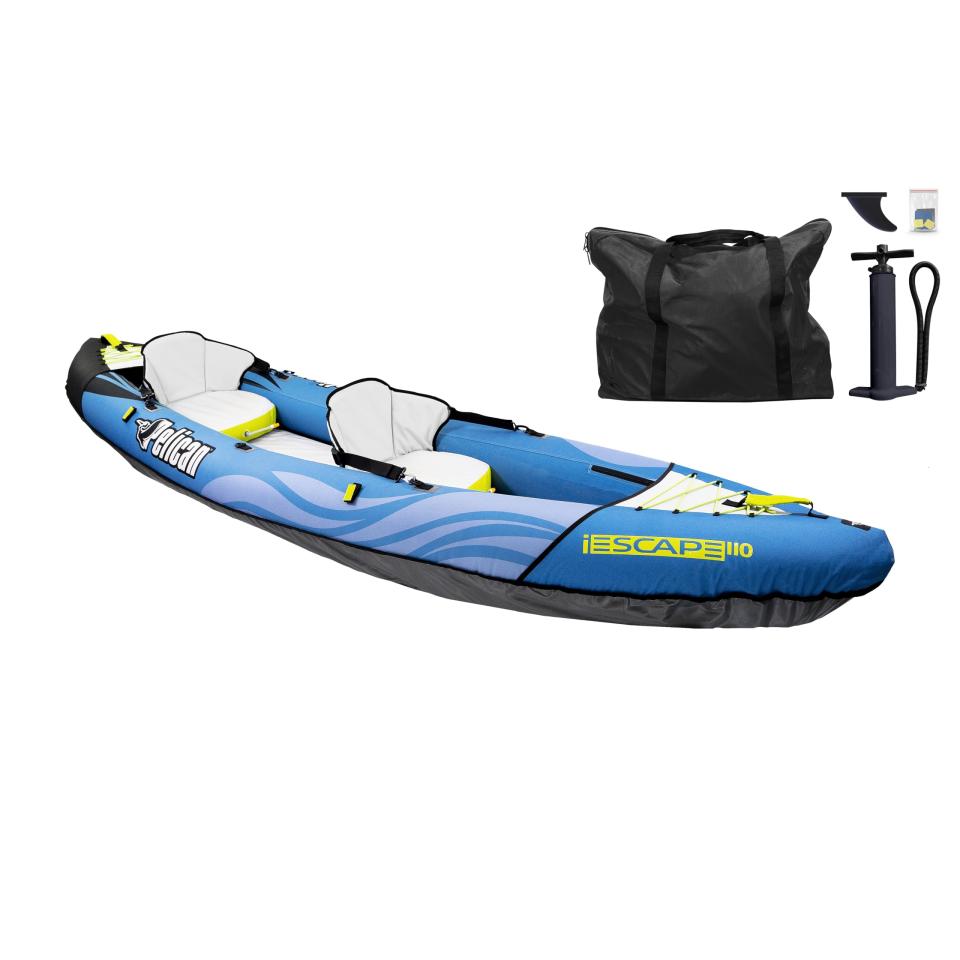
iEscape 110
amazon.com
$299.99
Straitedge Angler Pro
If you’re going fishing in your kayak, you need to look for both stability (to fight fish) and maneuverability (to find them). The Advanced Elements Straitedge Angler delivers both of these in spades.
Aluminum ribs are built into the hull of this boat, which deliver the dual benefit of enhanced rigidity on the floor and better tracking thanks to the lines they add to the bottom of the craft.
The high-backed aluminum framed seat makes the Straitedge plenty comfortable to float in for hours, even if you aren’t getting into any fish. Additionally, Advanced Elements’ accessory frame system is remarkably efficient at holding all the fishing gear you need for a successful day on the water.
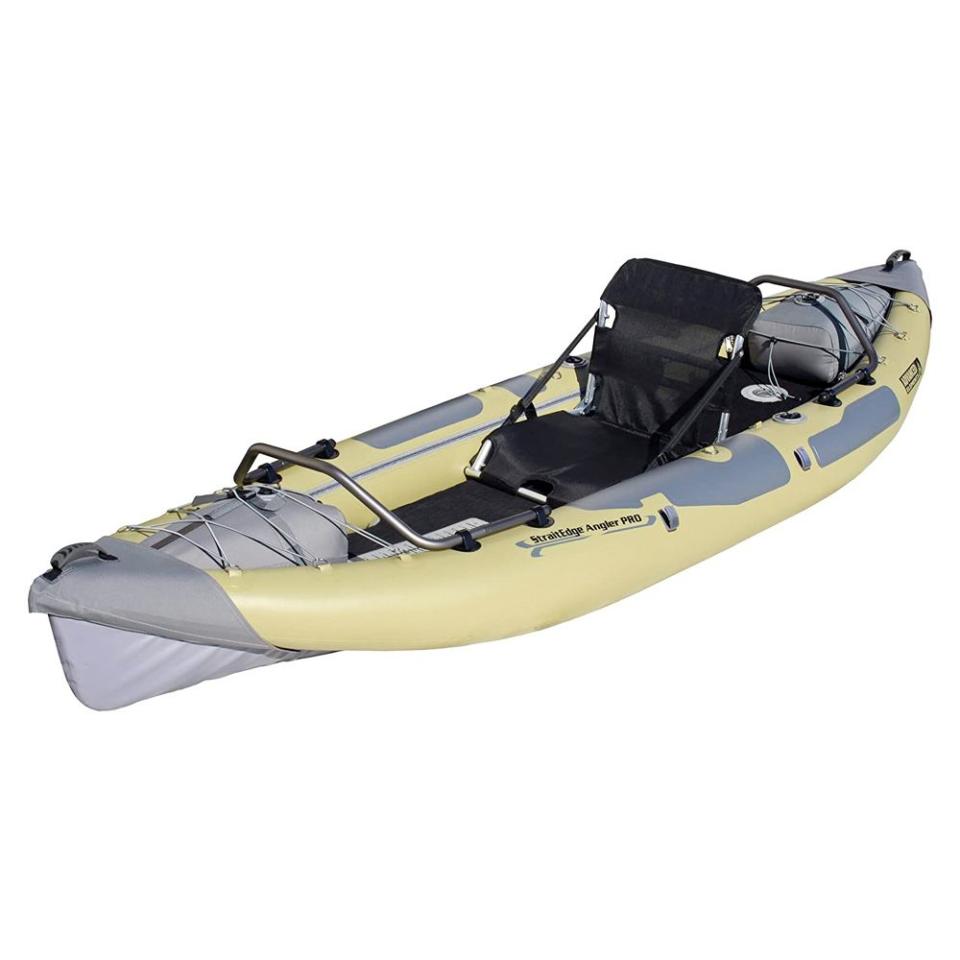
Straitedge Angler Pro
amazon.com
$893.00
Refuge
Ultralight packrafts are more than a trend at this point, winning boaters with their low weights and portability. Standard inflatable kayaks often weigh upwards of 30 pounds, but many packrafts are far lighter. Case in point, Alpacka’s new and Refuge packraft weighs less than seven pounds. It’s easy to bring along on just about any kind of adventure, whether you’re shouldering it to a high-alpine fishing lake, accessing a remote river or bikepacking it as part of your shuttle.
Alpacka packrafts are known for their durability-to-weight ratio, and the updated Refuge features a sturdier floor made with 840-denier nylon, and a 210-denier high-count nylon hull—so there’s no need to worry about punctures. It also comes with a backband, inflatable foot brace and two-point thigh straps to hold you in when the going gets rough.
We tested its mettle on the rivers and lakes of Northwest Colorado. Packed up into a tent-sized roll, it was easy to carry strapped to the side of a daypack. The optional cargo fly, an airtight zipper that lets you stash gear inside the tubes, is a game-changer. It keeps your stuff out of harm’s way and doesn’t mess with your center of gravity. While there are other packrafts out there, Alpacka remains the gold standard. The brand pioneered the category in its home state of Alaska, and that heritage shows in the Refuge’s design and craftsmanship.
One final note: We recommend the smaller “medium”-size Refuge to optimize for low weight, but there is a 89.5-inch “large” model for larger paddlers, which features a slightly higher 275-pound weight limit.
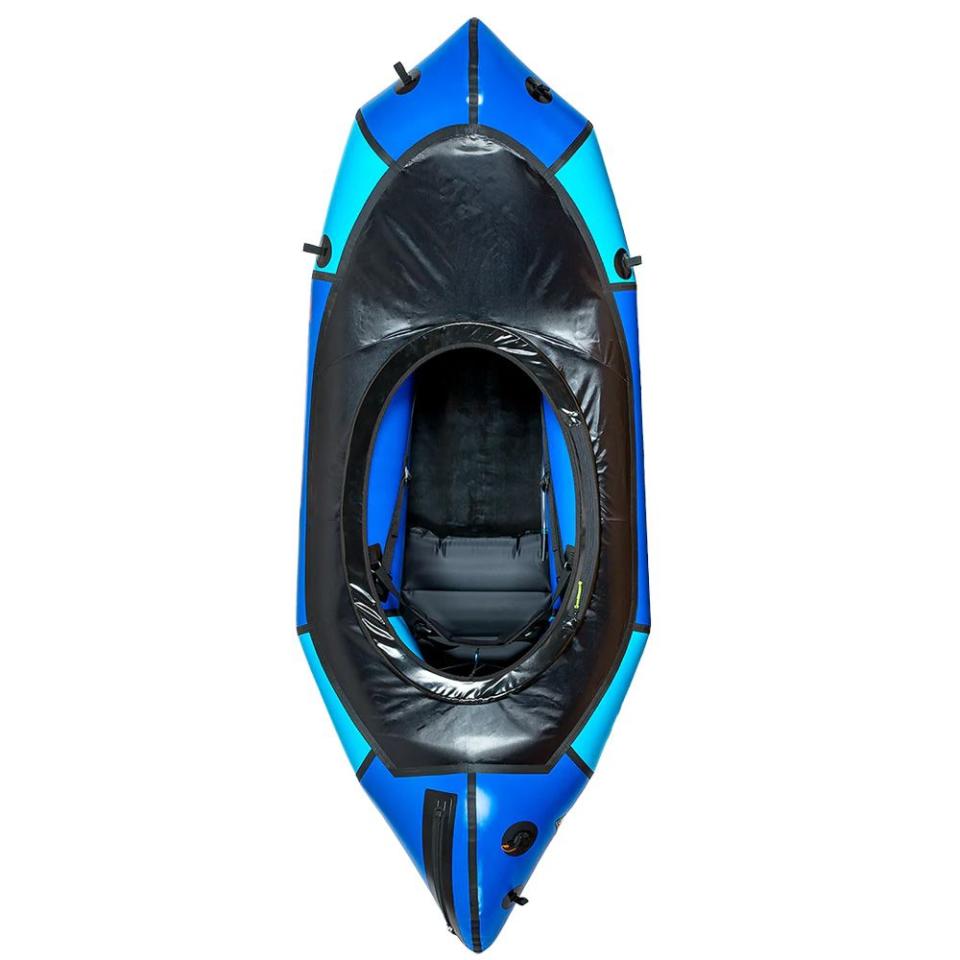
Refuge
alpackaraft.com
$1325.00
Switch Pro
Can’t decide whether you want to bring a paddleboard or a kayak? You won’t have to choose if you bring along the Isle Switch Pro, a paddleboard-kayak hybrid that lets you stand or sit while you paddle. Pumped up to the recommended 17 PSI, stringers of carbon-based Infinity Fiber keep it rigid, enhancing glide and performance, while welded rails make it bombproof. It’s 11-foot-6-inches long, but weighs just 19 pounds, making it easy to carry around and even easier to paddle.
To switch from paddleboard to kayak, simply install the kayak seat and footrest wherever you want them. The breakdown paddle comes with an extension that turns your SUP handle into a kayak blade, which is a nice touch. Packing up is easy too: Just roll it up and store it in its carrying backpack.
As a bonus, it comes with a mount that allows you to add a 3-horsepower electric motor to give you a bit of paddle-assist when your arms run out of gas. E-motor-makers like Bixpy and Torqueedo make closed-prop systems that fit perfectly, either built-in to a special fin or that attach to the stern, letting you steer with a handle.
That’s the largest and most impressive of the Switch Pro’s many design flourishes. I love the full-length soft/grippy traction pad, which makes it sturdy enough for yoga or lounging, even with your kids and/or pets. Its side loops let you easily strap on gear via infinite clip-on points. It also comes with a good number of accessories, including a carbon paddle (with extra blade), leash, pump, click fin, seat and foot brace, all included.
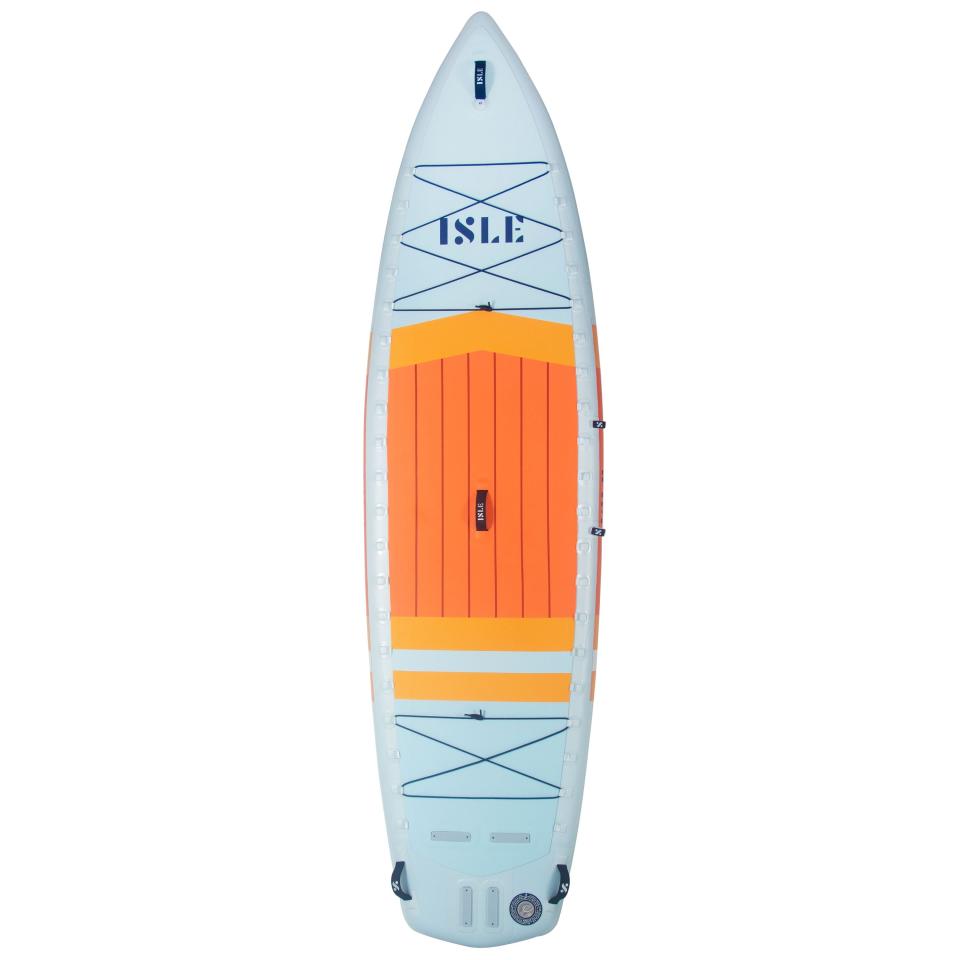
Switch Pro
islesurfandsup.com
$1095.00
Q+A with kayaking expert Joe Jackson
How do I store an inflatable kayak?
While you can really brutalize a well built inflatable while on lakes, rivers, and in oceans, we suggest giving your inflatable the white glove treatment when storing it. The plastics that most of these craft are built from don’t handle long term sun exposure well and even the heartiest of PVCs can be rendered useless if left in direct sunlight for a few months.
Mold is another scourge that can ruin a fancy inflatable boat when they are rolled up wet. We highly suggest storing an inflatable indoors and dry in a relatively temperature controlled setting.
What’s the best way to blow up an inflatable kayak?
Whether you own a high-end drop-stitched inflatable that can get nearly as rigid as fiberglass, or something more casual, you always want to get as much air in your boat as possible. With a higher PSI in the inflated space, you’ll get better tracking than if you leave your boat soft and floppy.
Personally, I prefer using an old fashioned hand pump to fill up my boat. Electric pumps can save your breath, but hand pumps deliver more force, which you need to make the kayak’s hull as stiff as possible.
Always top off your boat with a hand pump, even if you use an electric pump to fill it up 99 percent of the way, to make sure the boat is as stiff as possible.
When should I get a new inflatable kayak?
If your boat is leaking air from difficult to repair places like along a seam or at a valve, you should probably think about replacing your inflatable kayak.
If your boat isn’t holding air well, look for the leak by washing the inflated kayak with sudsy, soapy water—we like to use a teaspoon of dish soap in a gallon of water. When you pour the water on the boat, look for spots with big bubbles, which may be caused by a stream of leaking air. While you can patch a clean leak with a simple patch kit (which should come with any inflatable worth its brass), the valves and seams require more work than the average person can handle. At that point, it’s time to buy a fresh boat.

You Might Also Like

